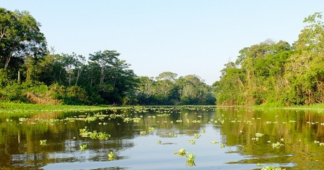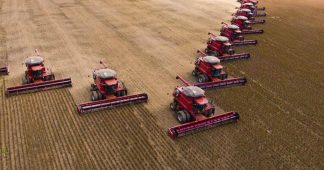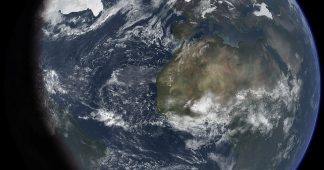6th November 2018
What if we abandoned photosynthesis as the means of producing food, and released most of the world’s surface from agriculture?
By George Monbiot, published in the Guardian 31st October 2018
It’s not about “them”, it’s about us. The horrific rate of biological annihilation reported this week– 60% of the Earth’s vertebrate wildlife gone since 1970 – is driven primarily by the food industry. Farming and fishing are the major causes of the collapse of both marine and terrestrial ecosystems. Meat – consumed in greater quantities by the rich than by the poor – is the strongest cause of all. We might shake our heads in horror at the clearance of forests, the drainage of wetlands, the slaughter of predators and the massacre of sharks and turtles by fishing fleets, but it is done at our behest.
As the Guardian’s recent report from Argentina reveals, the huge forests of the Gran Chaco are heading towards extermination, as they are replaced by deserts of soya beans, almost all of which are used to produce animal feed, particularly for Europe. With Jair Bolsonaro in power in Brazil, deforestation in the Amazon is likely to accelerate, much of it driven by the beef lobby that helped bring him to power. The great forests of Indonesia and West Papua are being felled and burnt for oil palm at devastating speed.
The most important environmental action we can take is to reduce the area of land and sea used by farming and fishing. This means, above all, switching to a plant-based diet: research published in the journal Science shows that cutting out animal products would reduce the global requirement for farmland by 76%. It would also give us a fair chance of feeding the world. Grazing is no answer to the ecocide caused by grain-fed livestock: it is an astonishingly wasteful use of vast tracts of land that would otherwise support wildlife and wild ecosystems.
The same action is essential to prevent climate breakdown. Because governments, bowing to the demands of capital, have left it so late, it is almost impossible to see how we can stop more than 1.5° of global warming without drawing carbon dioxide out of the atmosphere. The only way of doing it that has been demonstrated at scale is to allow trees to return to deforested land.
But could we go beyond even a plant-based diet? Could we go beyond agriculture itself? What if, instead of producing food from soil, we were to produce it from air? What if, instead of basing our nutrition on photosynthesis, we were to use electricity, to fuel a process whose conversion of sunlight into food is ten times more efficient?
This sounds like science fiction, but it is already approaching commercialisation. For the past year, a group of Finnish researchers has been producing food without either animals or plants. Their only ingredients are hydrogen-oxidising bacteria, electricity from solar panels, a small amount of water, carbon dioxide drawn from the air, nitrogen and trace quantities of minerals such as calcium, sodium, potassium and zinc. The food they have produced is 50 to 60% protein, the rest is carbohydrate and fat. They have started a company (Solar Foods), which seeks to open its first factory in 2021. This week it was selected as an incubation project by the European Space Agency.
They use electricity from solar panels to electrolyse water, producing hydrogen, that feeds bacteria (which turn it back into water). Unlike other forms of microbial protein (such as Quorn), it requires no carbohydrate feedstock – in other words, no plants.
Perhaps you are horrified by this prospect. Certainly, there’s nothing beautiful about it. It would be hard to write a pastoral poem about bacteria grazing on hydrogen. But this is part of the problem. We have allowed a mythical aesthetic to blind us to the ugly realities of industrial agriculture. Instilled with an image of farming that begins in infancy, as about half the books for very small children involve a rosy-cheeked farmer with one cow, one horse, one pig and one chicken, living in bucolic harmony, we fail to see the amazing cruelty of large-scale animal farming, the blood and gore, filth and pollution. We fail to apprehend the mass clearance of land required to feed us, the Insectageddon caused by pesticides, the drying up of rivers, the loss of soil, the reduction of the magnificent diversity of life on Earth to a homogenous grey waste.
The compound the Finnish researchers have produced from air, water and electricity is most likely to be used as a bulk ingredient in processed food. But (though this goes well beyond the company’s current plans) is there any reason why, with modifications of the process, it could not start to deliver the proteins required to make cultured meat, or the oils that could render palm plantations redundant? Is there any reason why it should not eventually replace much of what we eat?
According to the researchers’ estimates, 20,000 times less land is required for their factories than to produce the same amount of food by growing soya. Cultivating all the protein the world now eats with their technique would require an area smaller than Ohio. The best places to do it are deserts, where solar energy is most abundant. When electricity can be generated at €15 per megawatt hour (a few years hence), their process becomes cost-competitive with the cheapest source of soya.
Could a similar technique also be used to produce cellulose and lignin, eventually replacing the need for commercial forestry? Is there any inherent reason why the hydrogen pathway could not create as many products as photosynthesis does today? Could it help to change our entire relationship with the natural world, reducing our footprint to a fraction of its current size?
There are plenty of questions to be answered, plenty of possible hurdles and constraints. But think of the possibilities. Agricultural commodities, currently using almost all the Earth’s fertile land area, could be shrunk into a few small pockets of infertile land. The potential for ecological restoration is astonishing. The potential for feeding the world, a question that has literally been keeping me awake at night, is just as electrifying.
None of this means we can afford to relax and wait for an infant technology to save us. In the meantime, as urgent intermediate steps, we should switch to a plant-based diet and mobilise against the destruction of the living planet. You could start by joining the Extinction Rebellion that launches today [Wednesday].
But if this works, it could help, alongside political mobilisation, to change almost everything. Places which have become agricultural deserts, trashed by giant corporations, could be reforested, drawing carbon dioxide from the air on a vast scale. The ecosystems of land and sea could recover, not just in pockets but across great tracts of the planet. A new age of global hunger becomes less likely.
Crude and destructive technologies got us into this mess. Refined technologies can help get us out of it. The struggle to save every possible species and ecosystem from the current wave of destruction is worthwhile. One day, perhaps within our lifetimes, they could repopulate a thriving world.











